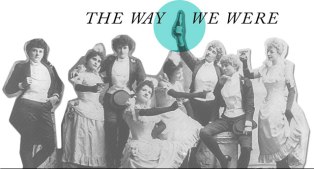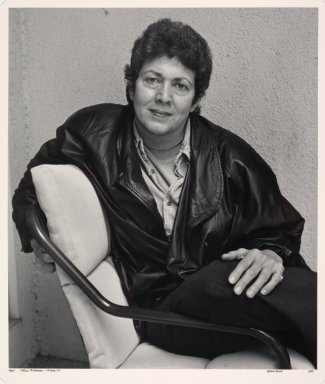
June is LGBT Pride Month, so we’re celebrating all of our pride by feeding babies to lions! Just kidding, we’re talking about lesbian history, loosely defined as anything that happened in the 20th century or earlier, ’cause shit changes fast in these parts. We’re calling it The Way We Were, and we think you’re gonna like it. For a full index of all “The Way We Were” posts, click that graphic to the right there.
Previously:
1. Call For Submissions, by The Editors
2. Portraits of Lesbian Writers, 1987-1989, by Riese
3. The Way We Were Spotlight: Vita Sackville-West, by Sawyer
4. The Unaccountable Life of Charlie Brown, by Jemima
5. Before “The L Word,” There Was Lesbian Pulp Fiction, by Brittani
6. Read a Fucking Book: Odd Girls and Twilight Lovers, by Riese
![]()

Because of the patriarchy and other looming dark forces at work in the universe, most queers grow up with no real awareness of their own history unless they seek out the information themselves or, you know, major in Queer Studies at Smith. (Or whatever it is you kids are calling it these days.)
I gave myself a crash-course in Queerness in 2006, tackling a formidable reading list that included novels, essay collections and non-fiction books like Bisexuality and the Eroticism of Everyday Life and The Girls Next Door. In the ensuing years, I started this website and, writing about lesbian issues every day, found myself giving myself mini-LGBT-history-crash-courses near-daily in order to write about LGBT news from a perspective of seeming authority.
When you’re immersed in this stuff all day every day, it can get legitimately frustrating, but also humbling, to be repeatedly reminded of how much I have left to learn. But also there’s no time! Then I saw the Canadian TV Show Bomb Girls, about women working in a bomb-making factory during World War II, and for some reason that show jumpstarted a full-fledged Herstory Phase, in which I am presently wallowing. My gateway book was arguably the most referenced book on the topic, Lillian Faderman’s Odd Girls and Twilight Lovers: A History of Lesbian Life in Twentieth-Century America. If you’re looking for a place to kick off an Independent Study, I think this is a good place to start.
The book was first published in 1991 by Columbia University Press, and a year later Viking Penguin purchased paperback rights to the book, which expired last year, inspiring a commemorative twentieth-anniversary re-issue from Columbia University Press, published on Valentine’s Day 2012. An interview with Faderman appears in the May/June issue of The Gay & Lesbian Review.
Faderman is a serious authority on lesbian culture and history, having penned heaps of books including To Believe in Women: What Lesbians Have Done For America – A History, Gay L. A.: A History of Sexual Outlaws, Power Politics, And Lipstick Lesbians (which I’m picking up from the library tomorrow! Yay!), Surpassing the Love of Men: Romantic Friendship and Love Between Women from the Renaissance to the Present and Chloe Plus Olivia : An Anthology of Lesbian Literature from the 17th Century to the Present.
Drawing from interviews, archive materials, journals, unpublished manuscripts, novels, pop culture artifacts and letters, Faderman traces lesbian history from the surprisingly unencumbered “romantic friendships” and “Boston Marriages” of the late 19th and early 20th centuries up through the Harlem Renaissance, two World Wars, the puritanical 50’s, the feminist movement, Lesbian Nation and the eventual emergence of Queer Nation and ACT UP! in the early 90s. It’s engaging, thorough, and fascinating.

There are so many things to learn about, you guys! So many things! I think we’re sold this idea that lesbians hid in their basements until the 70s, but that’s not true. In fact, it was information garnered from this book that inspired me to write my brilliant Ten Great Places To Meet Other Lesbians If You Have a Time Machine.
The bulk of the focus is on white middle-class cisgender lesbians, who, as the least disenfranchised and most populous group, produced the most documentation and source materials and also obviously had way more freedom and agency to live out their lesbianism than most anybody else. But Faderman consistently does strive to address the issues of working-class women and women of color, and states in her introduction that “for the chapters for which I could locate women to tell me about their experiences (beginning with the 1920s) I was anxious to do so, not only to round out the picture of lesbian life by a conscious attempt to look at class, age, ethnic and geographical diversity, but also to provide this study with their living voices.” She displays awareness throughout of the various conflicts between different groups of lesbians and of the racist, classist and ageist attitudes that characterized the dominant group consistently over time.
It’s chilling to read the back-and-forth between each triumph of queer culture and the inevitable backlash that followed it, and to trace the numerous societal forces that have conspired to make the world fear gay people — the near-arbitrariness of the modern Conservative religious push against LGBT rights comes into clear focus when you see it as just the latest opportunity for a ruling class to maintain or enhance their power at our expense. But the book isn’t about politics, really, and the most exciting part of the book is what survived and sometimes thrived despite all that, or because of it, and how that all led to where we are now.
Basically what I’m telling you is that if you’re as excited about The Way We Were as I am, and you haven’t read this book, you should read this fucking book. That’s all there is to it.







